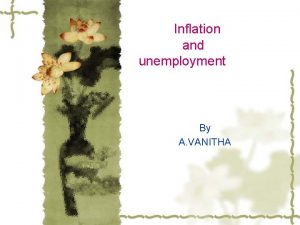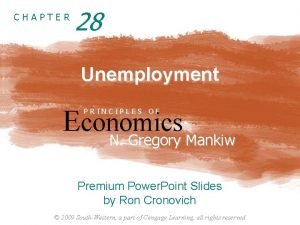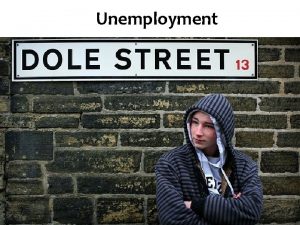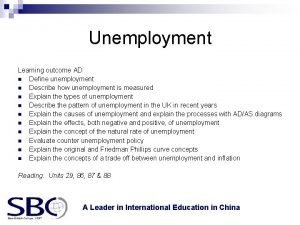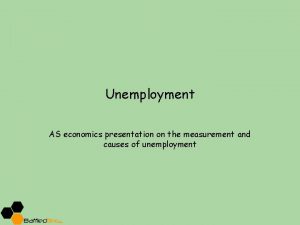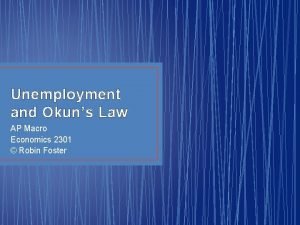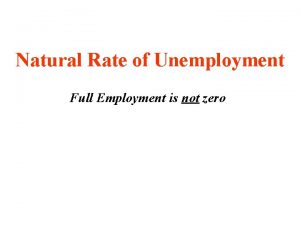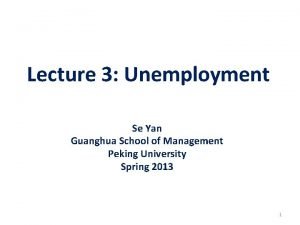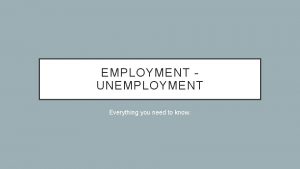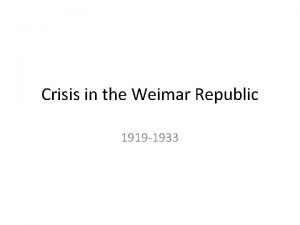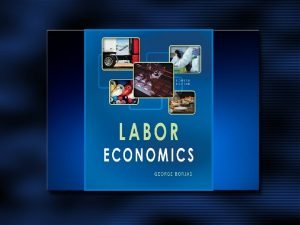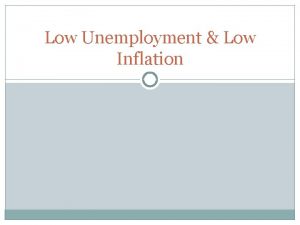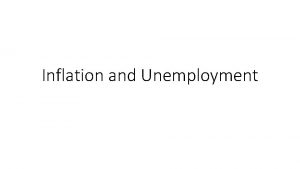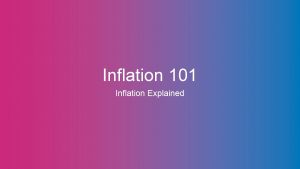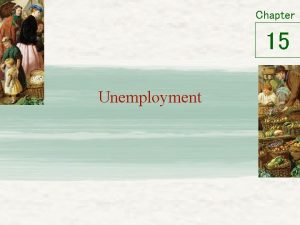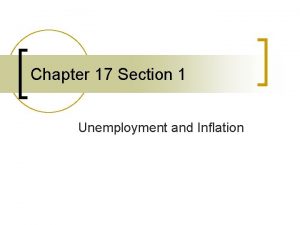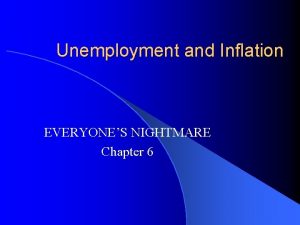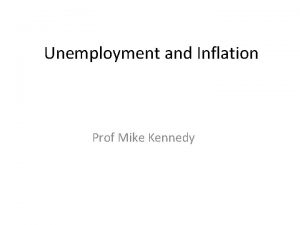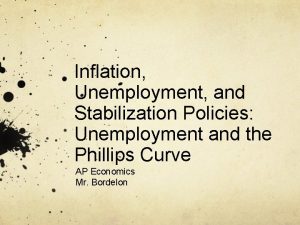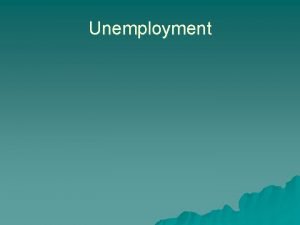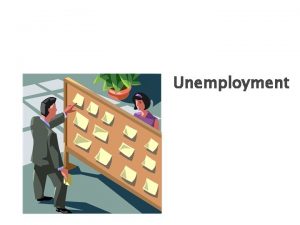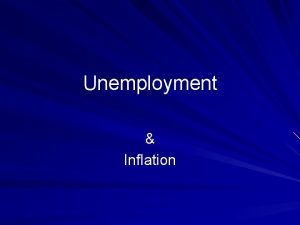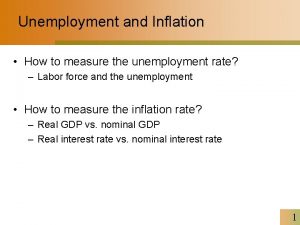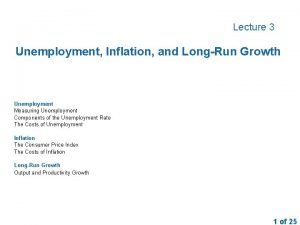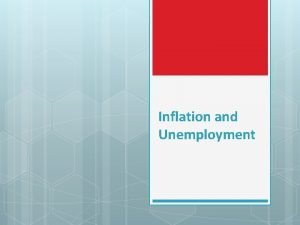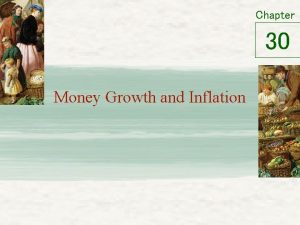Chapter 11 Inflation and Unemployment Inflation w Is




























- Slides: 28

Chapter 11 Inflation and Unemployment

Inflation w Is the general increase in the prices of goods and services in an entire economy. w For ex: an annual inflation of 3% would mean that there is an overall increase in prices by 3% w Deflation is the general decrease in the level of prices

The Consumer Price Index w CPI is used to measure price changes for a typical “basket” of consumer products. w CPI is one indicator of inflation or changes in the cost of living. w Statistics Canada calculates CPI to see what the typical Canadian mostly buys. For ex. in 1986 housing was the biggest expenditure

The Consumer Price index…. . Results of 1994 survey Prices Quantity Consumed Expenditure Weights Hamburgers $2. 00 10 $20 0. 4 milkshakes $1. 00 30 $30 0. 6 $50 Prices in 1995 Prices 1995 Price x 1994 Quantity hamburgers $2. 20 x 10 = $22. 00 Milkshakes $1. 05 x 30 = $31. 50 $1. 05 $53. 50 CPI= ($53. 50 -$50) x 100 = 7 % = 1. 07 $50. 00

Nominal Vs Real Income w Nominal income is income valued in current dollars w Real income is when income is expressed in base-year dollars. w Real income = nominal income CPI w A consumer’s income has to increase at the same rate of inflation. w Purchasing power is inversely related to CPI w Therefore those whose incomes increase at a higher rate than CPI enjoy a higher standard of living.

Limitations of the CPI w The CPI has 3 basic limitations, which under certain circumstances can severely reduce the CPI’s usefulness. w Consumer differences: some consumer’s preferences might not match up with the average consumer this causes discrepancies in item weights. w Changes in spending patterns: consumer consumption is constantly changing and Statistics Canada needs to constantly update item weights and contents w Product quality: the index cannot reflect changes in quality that are not matched by changes in prices

The GDP Deflator w Unlike CPI, the GDP deflator measures price changes for all goods and services and weights them in terms of the economy’s total output w the GDP deflator is updated yearly and is more accurate than the CPI but this causes the values of the GDP deflator to be less available than the CPI.

GDP Deflator…. . Year Output Price Output at 1994 GDP Current Price Deflator 1994 1000 $0. 20 $200 1. 0 1995 2000 $0. 30 $600 $400 1. 5 Much like the CPI, the base year has a value of 1, which is used as comparison for further years. To calculate the GDP deflator the Output at Current price is Divided by Output Price at 1994. In this example we see that inflation rate was 50% in 1995

Nominal vs. Real GDP w A nominal GDP is expressed in current dollars. w Real GDP, much like Real income, gives an indication of the purchasing power of an entire economy. w Real GDP= nominal GDP/ GDP deflator

Inflation Effects w In Figure 11. 5 in the text book (p 314) Canada’s inflation record since 1926 is illustrated. w Why are inflation rates considered a serious problem? They redistribute purchasing power in ways that can be economically harmful and unjust. w To see the effects of inflation lets look at the effects on household incomes and on borrowing and lending.

Incomes w If a household income increases steadily but inflation increases at a higher rate then the households lose purchasing power. w Fully indexed incomes: nominal incomes that automatically increase at the rate of inflation. w Partially indexed incomes: nominal incomes that increase at rates less than that of inflation. w Fixed incomes: nominal incomes that remain fixed at the same dollar amount regardless of inflation.

Borrowing and Lending w If the lender loans funds at an interest rate that is not adjusted for inflation, then the lender may lose out. w The nominal interest rate is the interest rate expressed in money terms. w Real interest rate = nominal interest rate inflation rate

Borrowing and Lending…. w For ex: Company A borrows $2000 at 5% per annum. So 5% would be the nominal interest rate. If the inflation rate is 3% the year Company A borrows the loan. Then the real interest rate would be 2%. w The real interest rate reflects the fact that due to inflation the loan has less purchasing power at the end of one year as opposed to the time when the loan was made. w Once the nominal rate has been agreed on the lenders have to anticipate the rate of inflation during the loan period and this rate is added into the nominal interest rate and is called inflation premium. w Nominal interest rate = desired real interest rate + inflation premium.

Borrowing and lending… w If the inflation rate is predicted to be 2% and the bank wanted a real interest rate of 3% the bank would receive real interest of $60 ($2000 x 0. 03) and an inflation premium of $40 ($2000 x 0. 02) w This is to compensate for the reduced purchasing power of the $2000. w If the inflation rate turns out to be higher than what was predicted then the lenders lose out.


INFLATION 100 100 200 200 300 300

What kind of income increases by less than the rate of inflation? Back

What are provisions for income adjustments to accommodate changes in price levels called? Back

What is the formula for real interest rate? Back

What kind of income is a nominal income that remains fixed at some dollar amount regardless of the rate of inflation? Back

Name 2 tools that are used to measure overall changes in price Back

What is the formula for nominal interest rate? Back

Name 3 limitations for the consumer price index Back

What is the formula for real income? Back

What is nominal GDP expressed in? Back

What was the biggest expenditure, according to Statistics Canada’s 1986 survey? Back

If a consumer spends $30 on hotdogs and $20 on Coke, what are the item weights of each good? Back

A workers original monthly income is $1000, and the inflation rate is 10%. If his income rises to $1100 what kind of income does he have? Back
 Relationship between inflation and unemployment
Relationship between inflation and unemployment Different types of unemployment
Different types of unemployment Principles of economics chapter 28 answers
Principles of economics chapter 28 answers Money growth formula
Money growth formula Supply side unemployment
Supply side unemployment Objectives of unemployment
Objectives of unemployment The 4 types of unemployment
The 4 types of unemployment Unemployment economics
Unemployment economics Types of unemployment
Types of unemployment Classical unemployment diagram
Classical unemployment diagram Causes of unemployment in south africa
Causes of unemployment in south africa Calculate unemployment rate
Calculate unemployment rate Cost of unemployment
Cost of unemployment Types of unemployment
Types of unemployment Solution of unemployment
Solution of unemployment Unemployment rate formula
Unemployment rate formula Unemployment ny
Unemployment ny Unemployment
Unemployment Paragraph about unemployment
Paragraph about unemployment Nairu
Nairu Macroeconomics
Macroeconomics Okun's law unemployment formula
Okun's law unemployment formula King lear historical context
King lear historical context Marx exchange value
Marx exchange value Examples of unemployment
Examples of unemployment Unemployment categories
Unemployment categories Weimar republic unemployment rate
Weimar republic unemployment rate Unemployment
Unemployment Unemployment
Unemployment

